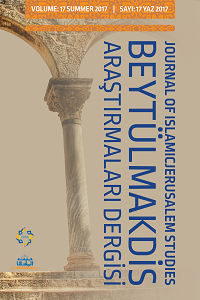
Journal of Islamicjerusalem Studies
Yazarlar: Alaa AL-
Konular:Tarih
DOI:10.31456/beytulmakdis.481640
Anahtar Kelimeler:Ar Mamluk Waqf,Bayt al-Maqdis,WomAwqaf,Zawiyah,Madrasah
Özet: ar Bayt al-Maqdis enjoys prestigious standing due to its special religious, cultural and historical status. Islamicjerusalem in general -and the holy city in particular- have received much interest in relation to the Awqaf ever since Caliph Umar ibn Al-Khattab brought the region under Muslim rule, with this interest being made obvious during the reign of the Mamluks in Palestine. This study sheds light on the Mamluks’ Waqf activity in Bayt al-Maqdis. It was during the reign of the Mamluks that there emerged one of the most important periods in the endowment of Awqaf: Waqf became related to all accepts of life for the community, including religious, educational, jihad, health and social aspects. Not only that but it supported governmental institutions in bringing prosperity to the community and providing various services to them. There have been many studies on the subject of Mamluk endowments or Awqaf in Bayt al-Maqdis, but few of these studies looked into the role of these endowments in people’s lives nor at the endowments made by Mamluk women or the roles played by these Awqaf in the cultural, religious, social and economic aspects. Yet this is particularly important especially considering the number of primary sources and documentations that have been revealed regarding Palestine in the Mamluk era, including those from the Al-Aqsa Mosque (al-Haram al-Sharif) archive, the records of the Ottoman land register, and the records of the Sharia Court. In the Mamluk era in Jerusalem, many Sultans, princes, merchants, and others chose to share a part of their wealth to progress society. They established various institutions and endowed a number of Awqaf. Each Waqf had its own title deed, demonstrating some of the aspects that comprised the general framework of the Waqf system. The Mamluks also benefited from the Waqf system in the countries they ruled, especially Bayt al-Maqdis, as a means of strengthening their rule and supporting their Jihad against the Mongols and the Crusaders. Sultan al–Zahir Baybars developed a new system for Awqaf different from Ahbas within the Dawawin (bureau). The Awqaf was thus divided into three bureaus: the first was for civil endowments; the second for mosques; and the third for the Awqaf of the two Harams and other forms of charity. This study illustrates analyses the archival records and deeds from the Ottoman Land register (Tabu) and the records of the Shari'ah Court of the Mamluk Waqf in Bayt al-Maqdis. The study concentrates on two main aspects of the Waqf in this period: the cultural aspect of Awqaf for Zawiyahs of knowledge, establishment of schools, libraries, and bookcases in mosques and colleges; and the other aspect concerning Mamluk women Awqaf in Bayt al-Maqdis, including the Waqfs of Lady Tunshuq and Ughul Khatun.